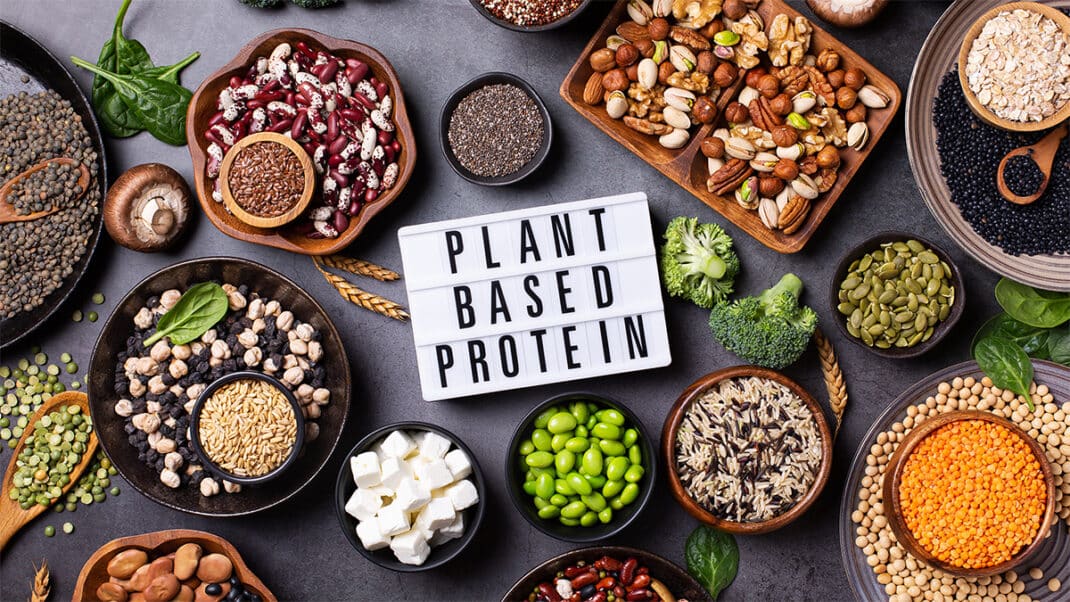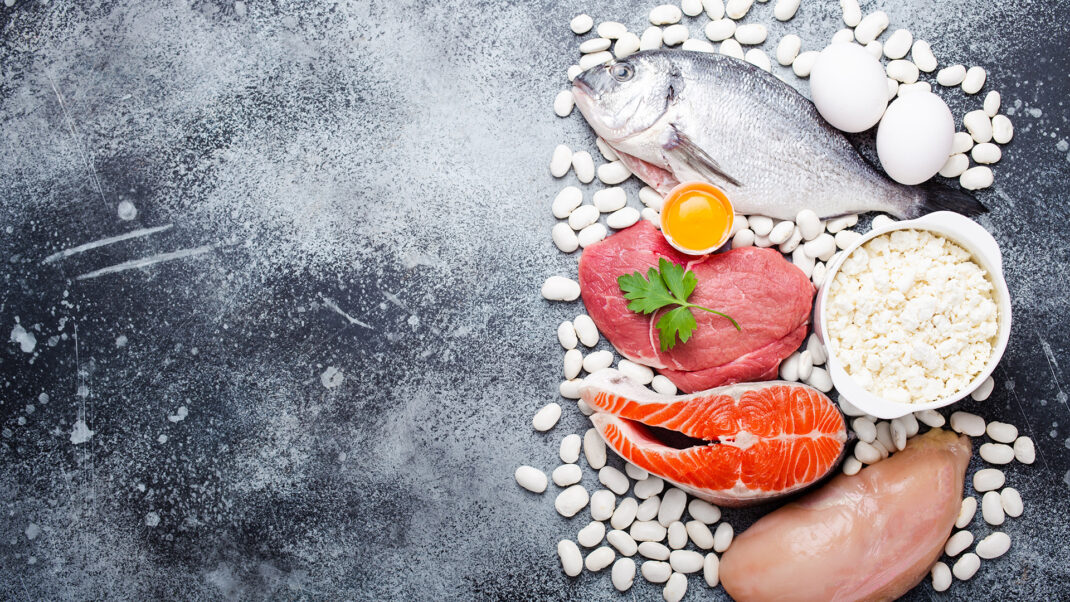5 Affordable Plant-Based Proteins to Meal Prep
The new research on nutritional value—and tips for ease of use.

Affordable protein sources, including plant-based proteins, are becoming increasingly important for clients as food costs continue to rise. While the 20-year average inflation rate for retail foods (ones bought to prep at home) is usually around 2%, prices for poultry and other meats (aside from beef and veal) have risen more than 14% between 2021 and 2022 (USDA-ERS 2023).
Clients may be wondering how they can stick to their grocery budget while still meeting their body’s protein needs. That’s where plant-based proteins shine. Not only are these foods becoming more popular (and therefore easier to find), but they’re also a hot topic of research, which has shown they are just as stellar at meeting nutrient and training needs as animal-based counterparts are. Here’s how to help educate clients on plant-based options and get creative with them in the kitchen.
How Much Protein Do Active People Need?
Protein is one of the three main macronutrients (alongside carbohydrates and fat) that active individuals need not only to survive, but thrive. Though all bodies need protein, this nutrient becomes increasingly important to athletes, thanks to its role in building and maintaining muscle, preventing injury and improving recovery. It also functions as an antibody (to fight off foreign invaders), as an enzyme (to carry out chemical reactions) and as a messenger (to foster communication in cells, tissues and organs) (Medline Plus 2021).
Reviews published in the journal Nutrients and in the Journal of the International Society of Sports Nutrition show that active individuals may need more protein than the current USDA Recommended Dietary Allowance (RDA) set at 0.8–1.0 grams per kilogram (g/kg) of body weight. After evaluating nearly 30 years of data, researchers found that people engaged in intense training may benefit from double the RDA amounts (i.e., 1.4–1.8 g/kg of body weight) to maintain protein balance (Kerksick et al. 2018; Carbone & Pasiakos 2019).
Sports dietitians agree with this increase as well. According to Natalie Rizzo, MS, RD, author of Planted Performance (NewSeed Press 2023) and founder of Greenletes, “Although each athlete is different, higher intakes are generally recommended for shorter periods of intense training. Most athletes benefit from a protein intake of around 1.6 g/kg (or 0.72 grams per pound) of body weight per day to maintain muscle mass.”
Rizzo adds that total caloric intake overall matters, too. “If athletes burn more calories per day than they consume, their bodies will start to break down lean muscle for use as fuel. Over time, this may lead to muscle wasting, injuries, illness and training issues.”
See also: 5 Big Benefits of Plant-Based Diets
Do Plant-Based Proteins Provide Complete Sources of Protein?
Previously, professionals thought that certain vegetarian foods must be consumed together in the same meal (e.g., beans and rice) to prevent a deficiency in essential amino acids. However, a 2019 review in Nutrients that explored available literature found that vegetarian diets can sufficiently meet protein and amino acid needs for individuals when a focus on dietary variety (across the course of the day) is emphasized (Mariotti & Gardner 2019). In fact, in developed countries, vegetarians who eat a balanced, variety-filled diet can easily meet (and often exceed) their daily requirements.
For example, the vegans and ovo-lacto vegetarians assessed in the 2016 EPIC-Oxford study took in 43 g/kg of the amino acid lysine, which is higher than the 30 g/kg recommended by the World Health Organization and the Food and Agriculture Organization (Schmidt et al. 2016; Joint WHO/FAO/UNU Expert Consultation 2007). The concern arises in less-developed countries where people predominantly or solely consume a single plant-protein source (rice or beans, not both). This can lead to deficits in the amino acid lysine (which is less present in grains) or methionine and cystine (which are less abundant in legumes).
Thus, it’s important health professionals say goodbye to outdated phrases like “incomplete protein” when talking with clients and instead focus on encouraging diet quality and plant-based protein variety.
5 Affordable Plant-Based Proteins
Here are 5 plant-based proteins that offer at least 5 grams of protein per serving in addition to other nutrients. Note: Some of the quick-fix recipes below offer more protein per serving and can work well as a stand-alone for a meal or snack. Others may work best when served as a protein, vegetable and/or healthy fat source alongside a meal.
Note: The estimated cost per serving in the following sections are based on Amazon.com and Target.com prices from April 2023. The nutrition breakdowns come from USDA FoodData Central.
1. Chickpeas
The USDA’s Dietary Guidelines for Americans 2015–2020 notes that beans such as chickpeas count as both a plant protein and vegetable. For clients who follow a predominantly plant-based diet, beans will likely count as a protein. Clients who eat more animal proteins will likely count beans as a vegetable. While dried beans tend to be more cost-effective, canned beans are still very affordable and offer the convenience that many busy, active individuals need.
Serving size: ½ cup cooked chickpeas
Cost per serving: 28 cents
Nutrients: 140 calories, 0 g fat, 23 g carbs, 7 g fiber, 7 g protein
2. Lentils
Like beans, lentils count as a protein and/or vegetable, depending on the makeup of your diet. And they are a tad bit cheaper (per gram of protein) than beans.
Serving size: 1 cup cooked
Cost per serving: 45 cents
Nutrients: 230 calories, no fat, 39 g carbs, 16 g fiber, 18 g protein
3. Hemp Seeds
Small but mighty, hemp seeds pack a powerful 10 g of protein per serving (USDA 2019). Hemp seeds are higher in fat than some plant-based proteins, but don’t worry: It’s predominantly the better-for-you unsaturated kind (omega-6 and omega-3s, to be exact). Plus, they’re filled with the amino acid arginine, which produces nitric oxide (NO) in the body. NO helps keep your blood flowing, which may also help with prevention of vascular conditions such as hypertension and heart disease (Napoli & Ignarro 2009).
Serving size: 3 tablespoons
Cost per serving: $1.12
Nutrients: 170 calories, 1.5 g saturated fat, 3 g carbs, 1 g fiber, 10 g protein
4. Pistachios
Pistachios are one of the only snack nuts that are a complete source of plant-based protein, meaning they contain all nine essential amino acids. They’re also the highest-protein snack nut, providing more than 10% of the daily value per serving. Per serving, you get 49 pistachios, which is nearly double the amount of almonds (23 nuts) or cashews (18 nuts) (USDA FoodData Central 2019).
Serving size: 1 ounce (about 49 pistachios)
Cost per serving: 89 cents
Nutrients: 160 calories, 2 g saturated fat, 7 g carbs, 3 g fiber, 6 g protein
5. Tofu
Versatile and convenient, soy-based products like tofu and tempeh work wonderfully in a plant-based diet. While it may take some time to adjust to the texture, for clients new to soy-based products, having some great recipes and meal-prep tips can help. Plus, at just about $2.00 a block, it’s very forgiving on the wallet if the first recipe trial doesn’t turn out!
Serving size: 3.25 ounces
Cost per serving: 56 cents
Nutrients: 140 calories, 1 g saturated fat, 3 g carbs, 2 g fiber, 17 g protein
Benefits of Meal Prepping Plant-Based Proteins
Getting clients on board with meal prep now will have them thanking you later. These five simple recipes are a great start to get them in their kitchens. Not only does meal prep make life easier during a busy week (when life unexpectedly throws a curve ball), but it also offers benefits to training as well. According to Rizzo, meal prep offers two critical benefits for active individuals.
Promotes Optimum Recovery
Consuming post-workout protein prompts muscle protein synthesis, which helps muscle rebuild and grow stronger. Prepping protein in advance means you have it on hand when you finish a workout (and you’re too tired to make anything).
Increases Satiety
Protein helps keep you full and satisfied for hours. Having protein prepped means you can easily add it to a meal, which may prevent overeating later. For instance, you can add lentils and pistachios to a salad to increase the satiety factor.
See also: Meal Prep Supersets: A Quicker Way to Eat Well All Week
Putting Plant-Forward Into Practice
Food costs will continue to rise. Help clients meet their training goals—affordably—by introducing them to the world of plant-based proteins. Encourage clients/patients to meal prep with plant-proteins (like lentils and tofu) and stock up on others (like canned beans and pistachios) to make it that much easier to meet these needs, optimize recovery and increase satiety. Or encourage a client to incorporate plant-based proteins alongside animal proteins, if that makes a plant-forward approach to nutrition more realistic for them.
Quick-Fix Dishes for Each Protein
Chickpeas: Chickpea Salad
Drain and rinse a can of chickpeas under cool, running water. This helps to lower the sodium by approximately 41% (Duyff 2011). Transfer to a bowl and mash with the back of a fork until a coarse consistency is achieved. Mix in 4 tablespoons plain Greek yogurt, 2 teaspoons red wine vinegar, ½ teaspoon celery seed, ½ teaspoon black pepper, ¼ teaspoon garlic powder and ¼ teaspoon salt. Add extras, like finely chopped red onion, as desired. Combine well. Store in an airtight container in the refrigerator. Use within 3 days for best quality.
Meal-prep tips: Serve with crackers or on a salad or eat as-is.
Lentils: Versatile Cooked Lentils
Rizzo recommends combining 1 cup of dry green lentils with 3 cups of water and a dash of salt. First, bring the water with lentils to a boil, then cover and reduce heat to simmer for 15 minutes or until all the water is absorbed. (Or after 15 minutes, drain off any remaining water.) Cooked lentils will keep in an airtight container in the refrigerator for up to 5 days, making them extremely versatile for easy additions to your menu.
Meal-prep tips: Lentils work well in place of traditional ground meats in Bolognese-style sauces and dishes like sloppy Joes. For quick tacos, toss them with salsa and serve in a wheat tortilla with guacamole, lettuce and tomatoes.
Hemp Seeds: Hemp-Pistachio-Date Bites
Snack happy with these seedy energy bites! To prepare, add about 15 pitted dates and 1/3 cup water to a microwave-safe jar, then microwave 30 seconds. Transfer cooked dates to a food processor fitted with a metal blade. Process, scraping down the sides as needed, until smooth. Add 1 teaspoon vanilla extract, ¼ teaspoon salt, 1 cup no-shell pistachios and 1 cup old-fashioned oats. Pulse until coarse (not like a butter, but rather a textured, finely chopped consistency). Transfer to a bowl, then stir in 1/3 cup hemp seeds and 1/4 cup mini dark chocolate chips. Refrigerate 15–30 minutes until set, then use a 1-ounce scoop to portion the mixture into balls. Store in an airtight container in the refrigerator. Consume within 2 weeks for best quality.
Meal-prep tips: Whether you’re sprinkling hemp seeds on a salad, over a slice of peanut-butter–banana toast, or into your favorite cooked dishes, hemp seeds are a great addition to bump up the protein in your diet.
Pistachios: Pistachio-Produce “Charcuterie” Alternative
Capitalize on the board-food trend for a fast meal! Fill a platter with a variety of fresh and dried produce (think leafy greens, carrots, peppers, apples, pears, apricots and prunes) and, if desired, cheeses like feta or goat. Add in two types of plant-based protein, such as pistachios and beans (or, for a different texture option, hummus). Consider pairing with a sweet, creamy prune dressing dressing that is free of added sugars and filled with slow-digesting carbohydrates. To prepare, blend 2/3 cup olive oil, 1/3 cup balsamic vinegar, 4 pitted prunes, 3 tablespoons water, 1 clove garlic, 1 tablespoon stone-ground mustard and a dash each of salt and black pepper. Drizzle over your favorite salad or plant-based dish. Store for 3–5 days in the refrigerator.
Meal-prep tips: While you can certainly snack on pistachios on their own, they work well incorporated with other protein foods as well. Think tossing them in place of other traditional “crunchy” textured ingredients in your meals. For instance, they work wonderfully when incorporated into a salad, as a “breading” on your tofu nuggets or chicken breast, and even as breadcrumbs in meatballs.
Tofu: Sweet and Sticky Tofu
To make the sauce: In a small bowl, combine 4 cloves minced garlic, ¼ cup low-sodium soy sauce, ¼ cup light brown sugar, 2 tablespoons sesame oil, 1 teaspoon cornstarch and 1 tablespoon sesame seeds. Whisk until well combined. Set aside.
To make the tofu: Warm 2 tablespoons vegetable oil in a large frying pan over medium heat. Add cut 1 block extra-firm tofu into bite-size pieces. Add to pan and cook on one side 5 minutes or until golden brown. Use a spatula to flip and cook 5 minutes longer, until other side is golden brown.
To combine: Add prepared sauce to pan and stir until tofu is well coated. Cook a few minutes, until sauce starts to caramelize, then remove tofu from pan. Serve immediately or store in a sealed container in the refrigerator for up to 3 days.
(Note: This is printed with permission from Rizzo’s book, Planted Performance.)
Meal-prep tips: Tofu can be purchased in silken form as well as in various stages of firmness, allowing for it to work with many recipes. For instance, an extra-firm tofu works great when preparing air-fryer tofu nuggets with a breaded coating, whereas a silken tofu works better for vegan cheesecakes and other sweet desserts.
References
Carbone, J.W., & Pasiakos, S.M. 2019. Dietary protein and muscle mass: Translating science to application and health benefit. Nutrients, 11 (5), 1136.
Duyff, R.L., Mount, J.R., & Jones, J.B. 2011. Sodium reduction in canned beans after draining, rinsing. Journal of Culinary Science & Technology, 9 (2), 106–12.
Joint WHO/FAO/UNU Expert Consultation. 2007. Protein and amino acid requirements in human nutrition. World Health Organization Technical Report Series, 935, 1–265.
Kerksick, C.M., et al. 2018. ISSN exercise & sports nutrition review update: Research & recommendations. Journal of the International Society of Sports Nutrition, 15 (38): doi.org/10.1186/s12970-018-0242-y.
Mariotti, F., & Gardner, C.D. 2019. Dietary protein and amino acids in vegetarian diets—A review. Nutrients, 11 (11), 2661.
Napoli, C., & Ignarro, L.J. 2009. Nitric oxide and pathogenic mechanisms involved in the development of vascular diseases. Archives of Pharmacal Research, 32 (8), 1103–08.
Medline Plus (National Library of Medicine). 2021. What are proteins and what do they do? Accessed April 6, 2023. medlineplus.gov/genetics/understanding/howgeneswork/protein/.
Schmidt, J.A, et al. 2016. Plasma concentrations and intakes of amino acids in male meat-eaters, fish-eaters, vegetarians and vegans: A cross-sectional analysis in the EPIC-Oxford cohort. European Journal of Clinical Nutrition, 70 (3), 306–12.
USDA (United States Department of Agriculture). n.d. MyPlate: Beans, peas, and lentils. Accessed April 1, 2023: myplate.gov/eat-healthy/protein-foods/beans-and-peas.
USDA-ERS (USDA Economic Research Service). 2023. Food prices and spending. Accessed March 28, 2023: ers.usda.gov/data-products/ag-and-food-statistics-charting-the-essentials/food-prices-and-spending/.
USDA FoodData Central. 2019. Chickpeas. Accessed April 1, 2023: fdc.nal.usda.gov/fdc-app.html#/food-details/173799/nutrients.
USDA FoodData Central. 2019. Hemp seeds. Accessed April 1, 2023: fdc.nal.usda.gov/fdc-app.html#/food-details/170148/nutrients.
USDA FoodData Central. 2019. Lentils. Accessed April 1, 2023: fdc.nal.usda.gov/fdc-app.html#/food-details/175254/nutrients.
USDA FoodData Central. 2019. Pistachios. Accessed April 1, 2023: fdc.nal.usda.gov/fdc-app.html#/food-details/170184/nutrients.
USDA FoodData Central. 2019. Tofu. Accessed April 1, 2023: fdc.nal.usda.gov/fdc-app.html#/food-details/172475/nutrients.
Elizabeth Shaw, MS, RDN, CPT
Elizabeth Shaw, MS, RDN, CPT, is a national nutrition expert, adjunct professor, personal trainer and four-time author who owns Shaw Simple Swaps, a nutrition communications business. Shaw appears frequently in the national media, both online and in broadcast, where she breaks down the latest nutrition science. Follow her @shawsimpleswaps.






